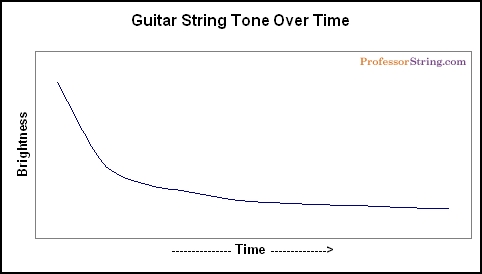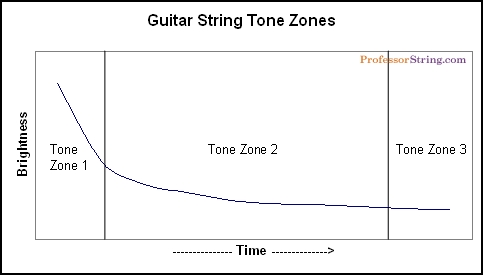
by Professor String


by Professor String |
What is The Guitar String Tone Curve Doing To Your Sound? |
|
In this article, we are going to take a look at the life cycle of a guitar string. As a guitarist or bassist, you know as soon as a set of strings are installed on your instrument, it sounds totally different. There is a world of difference in tone with the new strings compared to the old strings. This difference in sound is especially heard in the wound strings. Again, the sound is much brighter and alive. Interestingly, the tone immediately starts to change as soon as the strings are played over time. The change is much more noticeable for uncoated wound strings. There is a curve in Figure 1 that demonstrates how the tone changes over time for a wound string. The cleanest and brightest tone occurs at the steepest point of the curve. The flattest sound occurs at the lowest point on the curve.

Figure 1
In Figure 2, the curve has been divided into three zones. These zones represent significant milestones in a string’s life cycle.

Figure 2
In Tone Zone 1, you have a tone that is typical when the strings are brand new out of the package and freshly installed on the guitar. Some folks refer to this as the “Twang” sound that is characteristic of newer strings. Player who love that ultra clean bluesy howl, or country twang try to keep their strings in this zone. Bassist who enjoy that clean sounding string snap (similar to Marcus Miller) also gravitate in this tone zone. As soon as the string starts to transition into Tone Zone 2, they change strings. Tone Zone 1 has the least amount of time during a normal string’s life cycle. The decay of brightness in quick and can sometimes only last after a few hours of playing. If you want to keep your sound in this zone, then you will be changing strings more frequently.
In Tone Zone 2, there is a change in brightness that occurs, but its decay is less dramatic than in Tone Zone 1. In fact Tone Zone 2 lasts the longest as the strings are still clean sounding, and have good sustain. For guitarist who desire clean string tone with having any “twang” element in it, this is the zone they enjoy. Tone Zone 2 also provides more desired transparency for special effects pedals and distortion. Distorted power chords sound less hollow, and more full in this zone.
Finally, in Tone Zone 3 there is the least amount of brightness and clarity occurring. The string has the least amount of sustain in this zone. The strings tend to be more muted and softer in their ringing. This is a preferred sound for guitarist after that warm soft jazz tone. Guitarist using heavy gauge flatwound strings (over 0.013” diameter) will play strings into this part of the lifecycle. Since they typically do not bend the strings to extremes, the strings will work reliably well in this zone. In some cases, the strings can go for years without needing changed. In this zone, the reliability becomes questionable for lighter gauge strings as breakage becomes more likely.
As you can see from our string tone curves, the sound of a guitar or bass is always changing. String companies are continuously trying to lengthen the life cycle of a string. In other words, they are trying new ways to increase the longevity of each cycle. Now that you know about the three zones, which one are you playing in? For most players, they find themselves in Tone Zone 1, 2, or 3. Still, there are other players who are the Twilight Zone!
Do you have some thoughts about this article or the subject? Share it with everyone on the Professor's Forum.
|